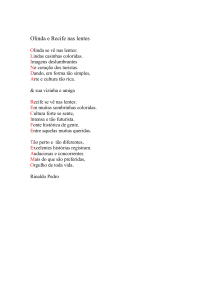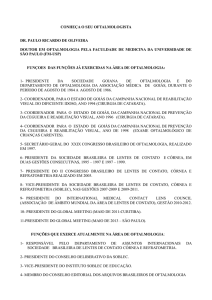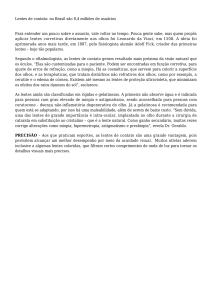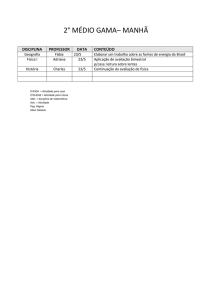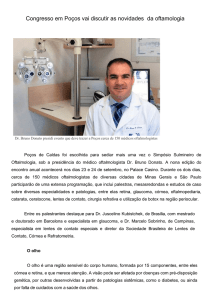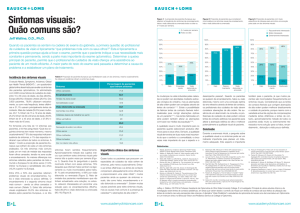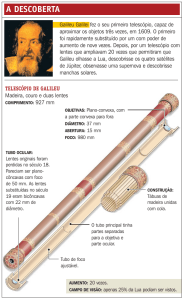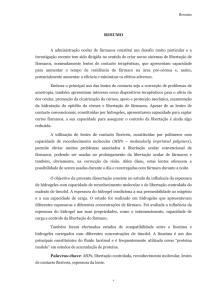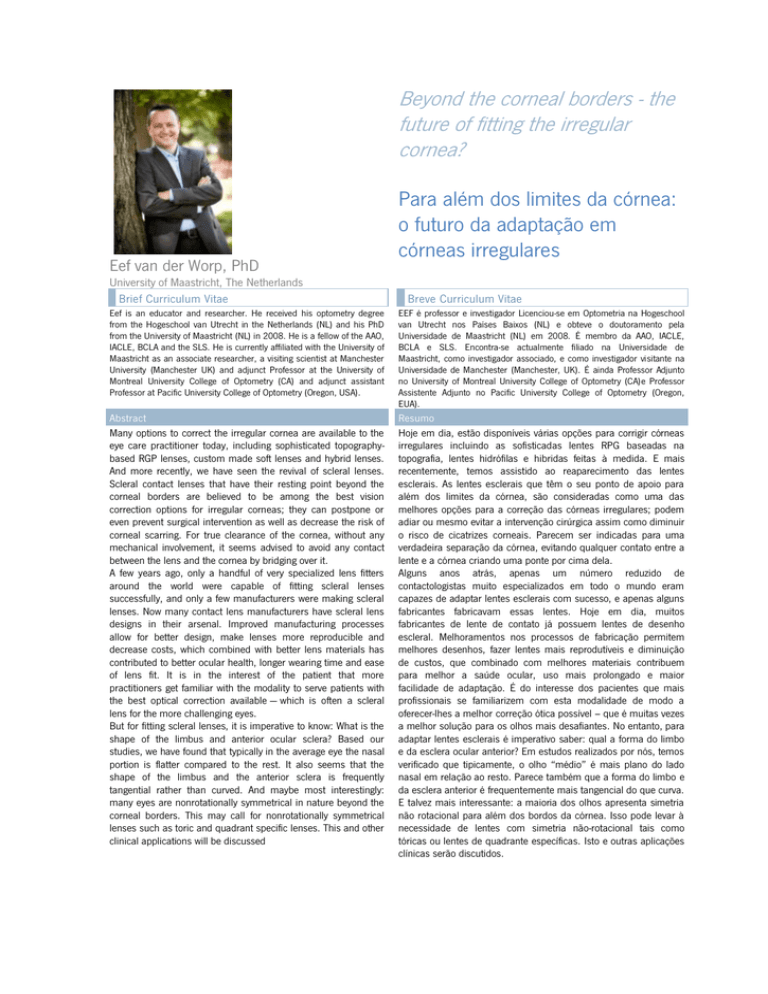
Beyond the corneal borders - the
future of fitting the irregular
cornea?
Eef van der Worp, PhD
University of Maastricht, The Netherlands
Brief Curriculum Vitae
Para além dos limites da córnea:
o futuro da adaptação em
córneas irregulares
Breve Curriculum Vitae
Eef is an educator and researcher. He received his optometry degree
from the Hogeschool van Utrecht in the Netherlands (NL) and his PhD
from the University of Maastricht (NL) in 2008. He is a fellow of the AAO,
IACLE, BCLA and the SLS. He is currently affiliated with the University of
Maastricht as an associate researcher, a visiting scientist at Manchester
University (Manchester UK) and adjunct Professor at the University of
Montreal University College of Optometry (CA) and adjunct assistant
Professor at Pacific University College of Optometry (Oregon, USA).
EEF é professor e investigador Licenciou-se em Optometria na Hogeschool
van Utrecht nos Países Baixos (NL) e obteve o doutoramento pela
Universidade de Maastricht (NL) em 2008. É membro da AAO, IACLE,
BCLA e SLS. Encontra-se actualmente filiado na Universidade de
Maastricht, como investigador associado, e como investigador visitante na
Universidade de Manchester (Manchester, UK). É ainda Professor Adjunto
no University of Montreal University College of Optometry (CA)e Professor
Assistente Adjunto no Pacific University College of Optometry (Oregon,
EUA).
Abstract
Many options to correct the irregular cornea are available to the
eye care practitioner today, including sophisticated topographybased RGP lenses, custom made soft lenses and hybrid lenses.
And more recently, we have seen the revival of scleral lenses.
Scleral contact lenses that have their resting point beyond the
corneal borders are believed to be among the best vision
correction options for irregular corneas; they can postpone or
even prevent surgical intervention as well as decrease the risk of
corneal scarring. For true clearance of the cornea, without any
mechanical involvement, it seems advised to avoid any contact
between the lens and the cornea by bridging over it.
A few years ago, only a handful of very specialized lens fitters
around the world were capable of fitting scleral lenses
successfully, and only a few manufacturers were making scleral
lenses. Now many contact lens manufacturers have scleral lens
designs in their arsenal. Improved manufacturing processes
allow for better design, make lenses more reproducible and
decrease costs, which combined with better lens materials has
contributed to better ocular health, longer wearing time and ease
of lens fit. It is in the interest of the patient that more
practitioners get familiar with the modality to serve patients with
the best optical correction available — which is often a scleral
lens for the more challenging eyes.
But for fitting scleral lenses, it is imperative to know: What is the
shape of the limbus and anterior ocular sclera? Based our
studies, we have found that typically in the average eye the nasal
portion is flatter compared to the rest. It also seems that the
shape of the limbus and the anterior sclera is frequently
tangential rather than curved. And maybe most interestingly:
many eyes are nonrotationally symmetrical in nature beyond the
corneal borders. This may call for nonrotationally symmetrical
lenses such as toric and quadrant specific lenses. This and other
clinical applications will be discussed
Resumo
Hoje em dia, estão disponíveis várias opções para corrigir córneas
irregulares incluindo as sofisticadas lentes RPG baseadas na
topografia, lentes hidrófilas e hibridas feitas à medida. E mais
recentemente, temos assistido ao reaparecimento das lentes
esclerais. As lentes esclerais que têm o seu ponto de apoio para
além dos limites da córnea, são consideradas como uma das
melhores opções para a correção das córneas irregulares; podem
adiar ou mesmo evitar a intervenção cirúrgica assim como diminuir
o risco de cicatrizes corneais. Parecem ser indicadas para uma
verdadeira separação da córnea, evitando qualquer contato entre a
lente e a córnea criando uma ponte por cima dela.
Alguns anos atrás, apenas um número reduzido de
contactologistas muito especializados em todo o mundo eram
capazes de adaptar lentes esclerais com sucesso, e apenas alguns
fabricantes fabricavam essas lentes. Hoje em dia, muitos
fabricantes de lente de contato já possuem lentes de desenho
escleral. Melhoramentos nos processos de fabricação permitem
melhores desenhos, fazer lentes mais reprodutíveis e diminuição
de custos, que combinado com melhores materiais contribuem
para melhor a saúde ocular, uso mais prolongado e maior
facilidade de adaptação. É do interesse dos pacientes que mais
profissionais se familiarizem com esta modalidade de modo a
oferecer-lhes a melhor correção ótica possível – que é muitas vezes
a melhor solução para os olhos mais desafiantes. No entanto, para
adaptar lentes esclerais é imperativo saber: qual a forma do limbo
e da esclera ocular anterior? Em estudos realizados por nós, temos
verificado que tipicamente, o olho “médio” é mais plano do lado
nasal em relação ao resto. Parece também que a forma do limbo e
da esclera anterior é frequentemente mais tangencial do que curva.
E talvez mais interessante: a maioria dos olhos apresenta simetria
não rotacional para além dos bordos da córnea. Isso pode levar à
necessidade de lentes com simetria não-rotacional tais como
tóricas ou lentes de quadrante específicas. Isto e outras aplicações
clínicas serão discutidos.


